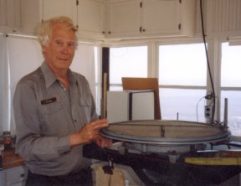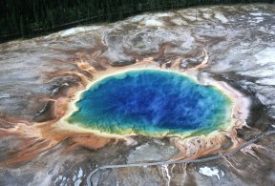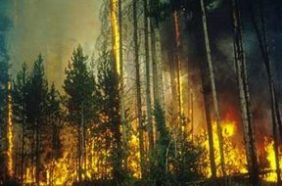Watching for wldfires in Yellowstone
Forest fires can cause considerable damage, yet entire ecosystems may depend on them for survival.
Share this:
- Share via email (Opens in new window) Email
- Click to share on Facebook (Opens in new window) Facebook
- Click to share on X (Opens in new window) X
- Click to share on Pinterest (Opens in new window) Pinterest
- Click to share on Reddit (Opens in new window) Reddit
- Share to Google Classroom (Opens in new window) Google Classroom
- Click to print (Opens in new window) Print
By Emily Sohn
I hiked for 5 hours to reach a remote mountaintop in Wyoming earlier this summer. George Henley had already been there for 22 seasons.
Every summer, George spends 3 months living in a one-room cabin on top of Mt. Holmes, a 10,330-foot peak in the northwest corner of Yellowstone National Park.
By day, he looks for fires, takes weather readings, and talks to the rare hiker who makes the rigorous 9.6-mile trek to his hut. At night, he stokes a wood-burning stove and hunkers down against cold winds. Every few weeks, a helicopter delivers groceries, firewood, and propane fuel. He sometimes goes 2 or 3 weeks without seeing anyone.
 |
|
George Henley with an Osborne Firefinder at his lookout atop Yellowstone’s Mt. Holmes.
|
| Gabe Keller |
“It gets lonely,” George says. “It’s the same view I see for years and years. I get tired of it sometimes. I sit here and think, ‘I’ll get out of here some day.'”
Luckily, he hasn’t left yet.
George is an important link in a national fire and weather reporting system, says Roy Renkin, a vegetation management specialist at Yellowstone.
Like George, other rangers are stationed at strategic vantage points in parks and on public lands all around the country. They keep records of wind, temperature, and humidity. They notice changes in the animals that show up from year to year. And, perhaps most important of all, at least in Yellowstone, they look for fires.
“They call in these smokes very quickly, before many people have a chance to see them,” Renkin says, referring to Yellowstone’s three firewatchers. “With the work they do, we’re able to initiate fire-management activities very soon after the fire gets observed.”
Wildfires flare up every summer all over the western United States. This past summer was especially dry in many areas, and numerous fires continue to blaze in California, Montana, Wyoming, and other states.
Experts disagree on how best to handle the blazes. Flames destroy property. They kill plants, animals, sometimes even people. Yet research continues to show that fire is a natural part of life. Entire ecosystems, in fact, may depend on it for survival.
Yellowstone wonders
Ever since Yellowstone became the first U.S. national park in 1872, it has been a prime tourist destination. It’s easy to see why. Old Faithful and other geysers spout water high into the air. Pungent gases bubble up through mud. Rivers of scalding hot water carve beautiful, alien landscapes that stink of sulfur.
Then, there are the animals. As we drove and hiked through the park, my friend Gabe and I felt like we were on a safari. We saw grizzly bears, elk, bison, wolves, antelope, and more.
 |
|
An aerial view of Yellowstone’s Grand Prismatic Spring.
|
| NPS Photo |
We weren’t the only ones impressed by Yellowstone’s geology and wildlife. An 11-year-old girl named Tessa, whose family was visiting the park from Seattle, was so impressed by the steaming hot-spring pools that she was writing down their names in a notebook.
“Lots of minerals!” Tessa said, when I asked her what part of the park was her favorite. Her 10-year-old brother Wesley looked bored until he started listing the animals he had seen so far—black bears, elk, deer, grasshoppers, prairie dogs—and the animals he still hoped to see: moose, wolves, jackrabbits.
Wildfires large and small
Fires deserve just as much attention as rocks and bears, Renkin insists. “We see the effects of fire on the landscape everywhere we look,” he says. “Even when you are looking at trees that are green, they are all born from an earlier fire.”
Most fires are small, Renkin says. They usually burn themselves out before they cause too much damage. And even though 3 years out of every 10 are dry enough to be serious fire years, historical records show that really big fires strike the Yellowstone area only once every 200 to 400 years.
“We don’t get them
very frequently,” Renkin says. “But when we do get them, we get them very, very hot, and we get total stand replacement.”
The summer of 1988 was a perfect example. That year, not a single drop of rain fell in August in the northern part of the park. “In 106 years of the fire record, we don’t see that anywhere,” Renkin says. “That was really something.”
At the same time, the park was full of big trees, some more than 200 years old. Renkin’s research has shown that old trees burn faster than young ones.
Together, those conditions were a recipe for disaster. More than 45 fires swept through Yellowstone that summer, Renkin says. Lightning ignited most of them. People started others. Fires burned for longer than 3 months and consumed more than 34,000 acres of forest until late summer rains and snow finally put them out.
“The sheer magnitude of these fires was so awesome,” Renkin says. “There were miles and miles of fire front moving along.”
Fire’s benefits
Even today, 15 years later, charred logs and dead trunks litter the park. On our hike to Mt. Holmes, Gabe and I passed through barren stands of blackened timber instead of lush blankets of trees that used to cover the base of the mountain. It saddened us that so many trees and animals had died in the blaze.
 |
|
A Yellowstone forest fire.
|
| NPS Photo |
On a long time scale, however, the 1988 fires started a whole slew of important events. Big fires clear the way for what scientists call succession. Winds blow in new seeds that take root in the bare soil. Because heat rises, bulbs and other underground plant parts often survive and sprout again.
It takes fallen logs 70 to 100 years to decompose, Renkin says. During that time, nutrients seep back into the dirt to feed future generations of plants and animals.
Some plants even rely on fire to reproduce. Lodgepole pines, the most common tree in Yellowstone, have a type of pinecone that sits in the treetops for years. In order to open and release their seeds, the cones need heat from a fire to unseal the glue-like resin that keeps them shut.
For all of these reasons, rangers at Yellowstone usually leave fire alone. “It kind of takes the forest back to a starting point,” Renkin says, “and the whole process starts all over again.”
Life on a mountaintop
No one is in a better position to observe this cycle of life and death than George Henley.
Over the years, he has watched the decline of black bears in the park, for one thing. Bears used to be so common, he told us, that a mamma bear and her two cubs once broke into his house, when he lived in a different part of the park. George later found them sitting in the woods, eating his can of cocoa.
There are also unexpected sightings. He once alerted park rangers when a rare group of mountain goats appeared near his lookout.
George has become an expert at spotting fires and reading weather. After we had finished eating lunch in his hut, he showed us his equipment: thermometers to measure temperature and dew point, wooden sticks that he weighs to calculate moisture in the air, a weather vane to read wind direction, and more. He calls all his readings in to park headquarters at about 1:30 p.m. every day.
I was most impressed by the Osborne Firefinder—an ancient-looking contraption that spins around and allows him to pinpoint the location of a fire on a map. The day we arrived, the viewfinder was pointed at a small blaze way down in a valley to the southwest. It had been burning for two days. “It’s picking up pretty good,” George noted.
To pass the many hours he spends alone, George reads books, works on his ham radio, and keeps a journal. Daily journal entries cover the things that you notice when you live on a mountaintop: animals, weather, fires. On Friday, Aug. 21, 2001, for example, George wrote: “It was pleasant and sunny today, so I washed clothes.”
If only life could always be so simple.
News Detective: Emily hikes up Mt. Holmes






